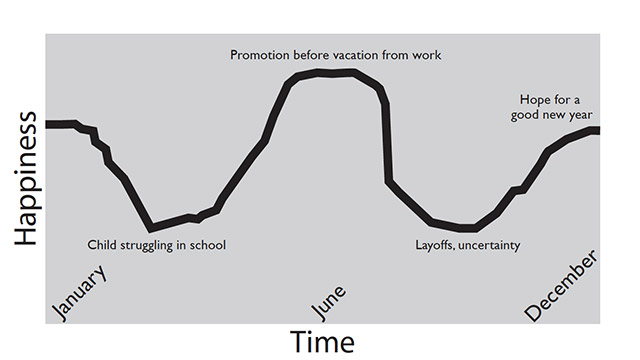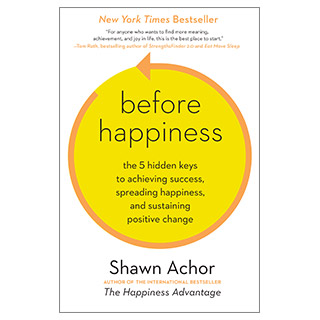How to Add More Meaning to Your Day
The author of Before Happiness shows us a simple, visual way to reevaluate our priorities—and our joys.

Illustration: Hero Images/Getty Images
If you're having trouble spotting the hidden meaning in your life, try an experiment I designed in 2011 for Pfizer, in which I asked employees and managers to think about the past year and then sketch a "happiness graph," which is simply a line graph with two axes: happiness and time.
So, for example, if you got a promotion in January and that made you happy, that should be a high point on the graph. Or if you were miserable in January, but then in early February your football team won the Super Bowl, you'd draw a spike on the graph. Then if in April you had a series of bad things happen at work, including not getting your expected raise, you'd likely draw a big dip. Then you label those events that dictated how you drew the graph.
For example:

The events or markers you included can uncover important yet hidden nodes of meaning in your life. In the Pfizer study, some of the managers' graphs fluctuated around events in their family life, both good (like their child winning a soccer tournament) and bad (like finding out their teenager had an eating disorder). Others were more oriented around world events, like the results of an election or the resolution of a conflict in Asia. For others, the events on the graph were entirely work-related.
Whatever our individual graphs look like, they help us understand what parts of our lives our happiness (or conversely, our unhappiness) depends upon. And in doing so, they help us see the areas that are clearly meaningful but that for some reason—whether busy schedules or misaligned priorities—may not have made it onto our mental radar.
For instance, a graph dominated by family events might reveal that we consider our relationships with our children highly meaningful, but if we are not currently putting a lot of time and attention into those relationships, that's a sign. Take a minute to reflect on your happiness graph. What do you find meaningful?
(Press Submit to save your responses. To view or edit, please refresh the page.)
 This excerpt was taken from Before Happiness: The 5 Hidden Keys to Achieving Success, Finding Happiness, and Sustaining Positive Change by Shawn Achor.
This excerpt was taken from Before Happiness: The 5 Hidden Keys to Achieving Success, Finding Happiness, and Sustaining Positive Change by Shawn Achor.
So, for example, if you got a promotion in January and that made you happy, that should be a high point on the graph. Or if you were miserable in January, but then in early February your football team won the Super Bowl, you'd draw a spike on the graph. Then if in April you had a series of bad things happen at work, including not getting your expected raise, you'd likely draw a big dip. Then you label those events that dictated how you drew the graph.
For example:

The events or markers you included can uncover important yet hidden nodes of meaning in your life. In the Pfizer study, some of the managers' graphs fluctuated around events in their family life, both good (like their child winning a soccer tournament) and bad (like finding out their teenager had an eating disorder). Others were more oriented around world events, like the results of an election or the resolution of a conflict in Asia. For others, the events on the graph were entirely work-related.
Whatever our individual graphs look like, they help us understand what parts of our lives our happiness (or conversely, our unhappiness) depends upon. And in doing so, they help us see the areas that are clearly meaningful but that for some reason—whether busy schedules or misaligned priorities—may not have made it onto our mental radar.
For instance, a graph dominated by family events might reveal that we consider our relationships with our children highly meaningful, but if we are not currently putting a lot of time and attention into those relationships, that's a sign. Take a minute to reflect on your happiness graph. What do you find meaningful?
(Press Submit to save your responses. To view or edit, please refresh the page.)
 This excerpt was taken from Before Happiness: The 5 Hidden Keys to Achieving Success, Finding Happiness, and Sustaining Positive Change by Shawn Achor.
This excerpt was taken from Before Happiness: The 5 Hidden Keys to Achieving Success, Finding Happiness, and Sustaining Positive Change by Shawn Achor.



